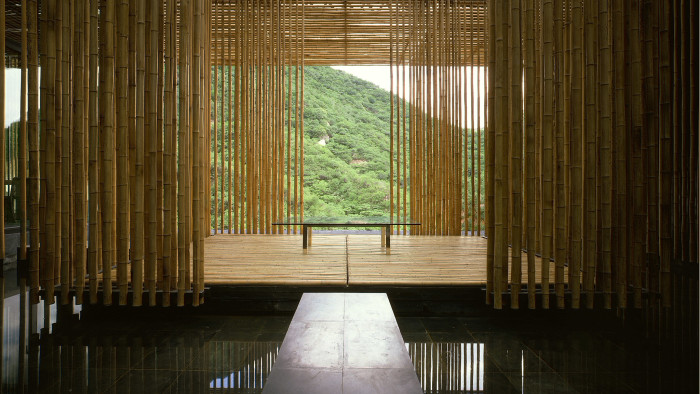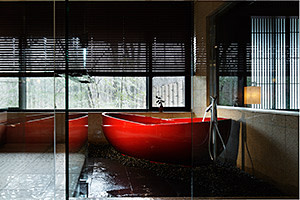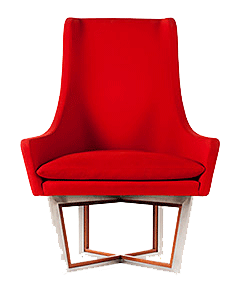The return of traditional Japanese materials in design

Roula Khalaf, Editor of the FT, selects her favourite stories in this weekly newsletter.
With its black slate floors, expansive white walls and subdued colour palette, Catherine and Taisuke Sasanuma’s Tokyo home is a model of contemporary chic.
But the Kengo Kuma-designed house in a leafy residential neighbourhood has a distinctive feature not usually associated with modern architecture – bamboo.
Kuma has used bamboo throughout the property, not only to enhance the exterior spaces but also to soften the visual impact of the building materials inside.
The lift, for example, which is encased in plastic, rather than hidden behind walls, is wrapped in hundreds of finely sliced bamboo slats, creating the effect of a bamboo waterfall cascading down three storeys.
One of Japan’s foremost architects, Kuma is at the forefront of a growing move to use traditional materials in current settings.
“There is an increasing number of architects and designers who feel a sense of nostalgia towards traditional materials, such as washi [paper], bamboo, tatami straw mats and wood, and want to use them,” says Kuma.
With the Sasanuma residence, Kuma shows how it is possible to combine a contemporary aesthetic with the traditional, natural materials that were central to the Japanese home, but fell out of favour in the 1970s and 1980s amid the country’s rush to catch up with the west.
In Great (Bamboo) Wall, a high-end, modern residence in a forest adjacent to the Great Wall of China, Kuma used bamboo for the ceiling of the kitchen and dining room, which he separated with a wall of bamboo poles placed at intervals close enough to provide a measure of privacy but wide enough to connect the two rooms spatially and visually.
“By bringing traditional materials into that kind of environment, it is possible to enhance the relaxed atmosphere of the space,” Kuma says.

Bamboo, Japanese washi paper and lacquer are also considered to be environmentally friendly. For example, as well as being extremely sturdy, bamboo grows quickly, making it both useful and ecological as a building material, says Yukio Hashimoto, an interior designer based in Tokyo.
At Tokyo’s Peninsula Hotel, for which Hashimoto designed the guestrooms, lobby and other public areas, he used a traditional weaving technique for the bedroom ceilings with “ajiro,” or thin strips of wood woven into a wickerwork pattern.
Hashimoto has also come up with innovative ways to use other traditional Japanese materials, particularly urushi lacquer.
Instead of the tableware that urushi lacquer has traditionally been associated with, Hashimoto uses it to coat ceilings, walls and tables.
Urushi is a handy coating material since it allows the wood, or whatever material it is covering, to show through, and it changes colour over time, so the longer you use it, the better it gets, he says.
Hashimoto also designs urushi products that are not generally associated with lacquer, including bathtubs, sink bowls and digital clocks.
Urushi is both sturdy and light, can withstand high temperatures and has anti-bacterial qualities, so it is perfect for bathtubs, he explains.
Japanese washi paper, which used to be a common feature of the home in the form of paper sliding doors and screens, is also finding new uses in contemporary homes and commercial spaces.
Tomita, a wallpaper and curtain distributor and retailer, offers a range of washi wallpaper that is handmade with paper mulberry fibres. The results can be subtle, with subdued colours and a matt finish, or highly luminous, as in the haku wallpaper made by covering the paper with extremely thin gold or silver leaf.
Washi may seem a delicate material for wallpaper, but it is actually stronger than pulp paper, says Hiromasa Tomita, president of his eponymous company. “We coat the surface, but only to the extent that the washi’s expression is maintained. Some washi wallpaper is so strong, it would be difficult to actually tear it.”
Hosoo, a maker and wholesaler of Nishijin brocade, weaves strips of washi into fabrics to make wallpaper, sofa fabrics and cushions.

One traditional technique developed by Nishijin weavers, which Hosoo has carried on, is to stamp the washi with gold leaf and then cut it into strips as thin as thread, which are then woven to create a luminous fabric.
Like washi paper and bamboo, Nishijin brocade – which was used in temples, favoured by the aristocracy and dates to 17th-century Kyoto – went out of favour during the westernisation of Japan.
But once companies such as Hosoo started to use the Nishijin technique to make contemporary designs, demand began to increase for wallpaper and soft furnishings, particularly from western fashion designers, including Dior, Chanel and Louis Vuitton, as well as high-end hotels such as the Ritz-Carlton and Hyatt group.
What distinguishes Nishijin fabrics is their subtle luminosity, says Masataka Hosoo, director of the company, which dates back to 1688.
One reason why luxury makers like Nishijin fabric is because even with gold and silver it is not glittery in a tacky way, like western fabrics in those colours can be, but has a delicate shine to it that does not compete with the products they are selling, he says.
Hosoo is spearheading a move to use Nishijin in unconventional products, from home furnishings to designer suits, and has even made a Tumi suitcase and Leica camera case in Nishijin fabric.
“Japanese crafts bring out the best qualities of natural materials,” says Hashimoto. But if those crafts are only used to make the same old, traditional products, they end up losing relevance to contemporary living, he adds.
By putting traditional materials to new use, a new generation of designers, craftsmen and distributors are committed to ensuring that these time-honoured crafts cannot only regain a place in modern life but also thrive and endure.
Photographs: Satoshi Asakawa; Nacasa & Partners
Comments